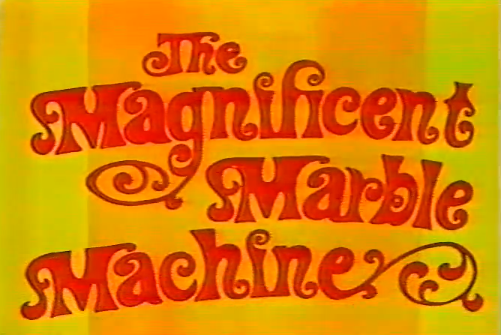| In
the 70s, pinball was all the rage that the makers of "Hollywood Squares"
decided to cash in on the craze by making a HUGE pinball machine and
having contestants play for cash and prizes instead of just points.
It...pretty much went the way you'd expect adults of the day playing
pinball to go...as in not good at all.
Game shows have been around since your
great-grandma "watched" them on her old hi-fi AM radio. And the dawn of
television only made the shows greater. But ask your average TV viewer
to name game shows and they'll throw the usual suspects at you: The
Price Is Right, Wheel of Fortune, Family Feud, Jeopardy!, Let's Make a
Deal, Match Game, Pyramid...MAYBE Card Sharks or To Tell The Truth if
they're true fans.
But, for every game show that's been around and remembered for decades,
there are dozens that didn't last very long at all. Whether the concept
was too hard to handle for casual viewers or the host seemed to be
phoning it in or it was placed between 11am and 12pm on weekdays, a
multitude of shows didn't get past one or two "seasons". Hell, they
sometimes don't get past the original 13-week run. And you...probably
don't remember them at all.
Well, I've been watching game shows since I was a preschooler. And there
were MANY times I turned off Bob Barker to see what those NOT named Mark
Goodson and Bill Todman came up with. I may not have liked them all,
but I usually remember the concept and appreciated the attempt to turn
people away from the old standards. And, as a public service to those
poor shows that were too odd, too subtle or too unlucky to last, I
started this column to clue you in on what you missed out on.
For each show, I'll start with the specs and a general statement. Then
I'll describe how the game is played. If the game has several stages,
I'll do each stage separately. Then I'll say - in my arrogant opinion -
what worked for the game at the time and what DIDN'T work. To close up,
I'll state whether the show could work as a revival of some sort today,
as well as where it would work if it could.
For the record, I will only do game shows I remember seeing, even if I
don't remember all the details.
On that note, let's start with a REALLY obscure one, one which, if I
recall, is the first "game show" I ever really watched:
 SHOW: THE MAGNIFICENT MARBLE MACHINE SHOW: THE MAGNIFICENT MARBLE MACHINE
AIR DATES: June 23, 1975 to March 12, 1976
CREATOR: Merrill Heatter/Bob Quigley
(better known for:) Hollywood Squares
HOST: Art James
WATCH IT AT: youtu.be/rU7n6Ncojx8 (Part 1)
In the 70s, pinball was all the rage. This was before Pong and Space
Invaders would make them relatively obsolete. The Who made a rock opera
about a boy who was excellent at it despite not being able to see and
hear. There was even a film in '79 based on the game called "Tilt".
Well, the makers of "Hollywood Squares" decided to cash in on the craze
by making a HUGE pinball machine and having contestants play for cash
and prizes instead of just points. It...pretty much went the way you'd
expect adults of the day playing pinball to go...as in not good at all.
HOW WAS IT PLAYED?
MAIN GAMEPLAY
Two contestants (one usually a returning champion) were teamed with two
celebrities in a first-to-five trivia game. A row of asterisks
indicating the answer would show on the bottom of a marquee and then, a
clue to it would scroll into view above it. The contestants OR the
celebrities (they alternate for each question) would buzz-in at any time
to give the answer. If they have no idea, letters are filled-in for the
answer over time until someone DOES buzz-in. For example, "*** *****
*****" is the answer and the clue is "THE PRESIDENT'S PAD"; the right
answer is "THE WHITE HOUSE".
Sometimes, a clue is too big to fit in 24 characters so the host gives
an extra part for it. For example, with "********" as the answer, the
host would say, "What are the biggest thing on this part of Elizabeth
Taylor's body?". The clue scrolled out on the marquee says, "HER
FINGERS", thus the answer being "DIAMONDS" (Yeah, all sorts of
"HS"-style innuendoes on this show).
First to five right answers is the champion and gets to play for cash
and prizes.
BONUS ROUND
The champion and the celebrity now controlled the "Magnificent Marble
Machine", a giant pinball machine with various "noisemakers", seven
"bumpers", two sets of "flippers" and two "ball over" holes. They have
two rounds to play, alternating between left and right flippers and who
gets to pull the "plunger" to put the ball into play. Once in play, all
"noisemakers" and "bumpers" the ball strikes earns points. Every time
the ball hits a "bumper" for the first time, the contestant wins a
prize. "Bumpers" 2 and 3 hide half of a larger prize like a car, a trip
or a boat; the contestant can only win that prize when both are hit. The
team can use the flippers to keep the ball in play for 60 seconds, after
which the flippers are deactivated.
A "target score" is set at 15,000 points for each new champion and
dropped by 1,000 for each return to the bonus round. Should the team
reach or surpass the "target score" in two rounds, the host allows one
more round with a golden "Money Ball" to be played. Instead of prizes,
the contest wins one dollar for every point scored.
In later episodes, the "noisemakers" were discontinued and only the
bumpers scored points (and cash in Money Balls). Also, a bonus prize was
given if all seven bumpers were hit at least once. In the last few
weeks, the Money ball was dropped; only prizes were won.
WHAT WORKED?
I must admit, trying to cash-in on the pinball craze WAS a good idea.
Even at the tender age of four, I knew what pinball was and was
fascinated by it. So, whenever the show was on TV, I was glued to
it...for the bonus round, at least.
Art James gave it his all as host, as always. He may not have had clue
one what the big deal was about pinball, but he kept the game exciting,
as a great host should.
WHAT DIDN'T WORK?
The main game was BORING! I mean, interesting concept...but people don't
tune into a show about pinball to see a standard quiz show with digital
Eggcrate-font readouts. Plus, it seemed the teams suffered from the
traditional 70s "lack of knowledge" that made all the Barry & Enright
Productions such a slog.
And the part that was SUPPOSED to be exciting? The pinball moved SO SLOW
in the "machine". They should've tilted it up a bit more to jazz things
up. Of course, the teams' hand-eye coordination were probably not as
good as your average teen-aged pinball player so...
Of course, the most confusing thing is that, once you get the rules of
the bonus round down, they change it. Yes, I know it's because a) the
"machine" was aging and b) too much money was given away. But that
should've been addressed during QA...assuming they ever DID that for
these game shows.
WOULD IT WORK TODAY?
Uh,......no. As I said at the start, video games made pinball
more-or-less obsolete. And, sure, they tried to make "video game shows"
like Starcade, Nick Arcade, Arena and the like, but none of them lasted
too long, either. These days, if you put the show on, millennials would
decry, "What the @#$% is this weird game they're playing?!" So, no;
leave it to history as a solid "nice try".
NEXT TIME: A true conflict of the opposite genders...
Chris Wolvie is neither a deaf, dumb nor blind kid. E-mail him at
chriswolvie@yahoo.com.
|


